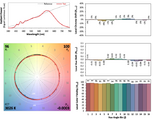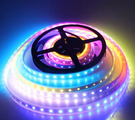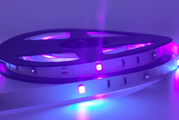What causes LED strip lights to heat up? What is the effective distance of LED strip lights?
Reasons why LED strip lights heat up
1. Circuit design issues: The most commonly used specifications for LED strip lights are 12V and 24V. 12V has a 3-string multi-channel parallel structure, and 24V has a 6-string multi-channel parallel structure. Since LED strip lights need to be connected together, the specific length of each type of light strip that can be connected has a lot to do with the width of the circuit and the thickness of the copper foil during design. Because the current intensity that the unit area can withstand is related to the cross-sectional area of the line, if this is not considered during wiring, then when the connection length exceeds the current that the line can withstand, the light strip will fail due to overcurrent. Heat not only damages the circuit board, but also reduces the service life of the LED.
2. Production process problems: Since the LED strip lights have a series-parallel structure, when a short circuit occurs in a certain group of circuits, it will cause the voltage of other LEDs in the same group to increase, and the brightness of the LEDs will increase, causing corresponding problems. The heat will also rise. The most obvious thing is that in the 5050 lamp strip, when any chip circuit of the 5050 lamp strip is short-circuited, the current of the short-circuited lamp bead will double, that is, 20mA becomes 40mA, and the brightness of the lamp bead will be reduced. It will become very bright, but at the same time the heat will also increase dramatically, and in severe cases, the circuit board will be burned out within a few minutes. However, because this problem is relatively obscure, people generally don’t pay much attention to it, because the short circuit does not affect the normal lighting of the light strip. If the employee in charge of the test only pays attention to whether the LED emits light, but does not check for abnormal brightness, or does not Appearance inspection, if only electrical testing is done, often ignores this problem, which is why many LED light strip manufacturers always encounter customer complaints that the product is hot but cannot find the reason.

Solution:
1. Line design:
The circuit should be as wide as possible. The spacing between lines should be 0.5mm. It is best to fill the rest of the space. The thickness of the copper foil should be thickened as much as possible without violating the customer's requirements for the total thickness of the circuit board. The general thickness is 1~1.5OZ;
2. Production process:
A. When printing solder paste, try not to allow tin connections between the pads to avoid soldering short circuits caused by poor printing;
B. Avoid short circuit when patching;
C. Check the patch position before reflow;
D. After reflow, perform a visual inspection first to ensure that there is no short circuit in the light strip before conducting an electrical re-inspection. During the re-inspection, pay attention to whether the LED is abnormally bright or dark after it is lit.
LED light strip installation method
1. Indoor installation:
When LED strip lights are used for interior decoration, they do not have to withstand wind and rain, so the installation is very simple. Each LED light strip has self-adhesive 3M double-sided tape on the back. When installing, you can directly peel off the sticker on the surface of the 3M double-sided tape, then fix the light strip where it needs to be installed and press it flat with your hands. What should I do if some places need to be turned around or are too long? It's very simple. The LED light strip is a circuit structure composed of a group of 3 LEDs connected in series and parallel. Every 3 LEDs can be cut off and used individually.
2. Outdoor installation:
Outdoor installation will be exposed to wind and rain. If 3M glue is used to fix it, the 3M adhesive will decrease over time and cause the LED light strip to fall off. Therefore, outdoor installation often uses card slots to fix it, which requires cutting and connecting. The method is the same as indoor installation, except that additional waterproof glue is required to consolidate the waterproof effect of the connection points.
3. Power connection method:
The general voltage of LED strip lights is DC 12V, so a switching power supply is required. The size of the power supply is determined according to the power and connection length of the LED strip lights. If you do not want each LED light strip to be controlled by a power supply, you can purchase a relatively high-power switching power supply as the main power supply, and then connect all the input power supplies of all LED strip lights in parallel (if the wire size is not enough, you can extend it separately). All are powered by the main switching power supply. The advantage of this is that it can be controlled centrally. The inconvenience is that it cannot realize the lighting effect and switch control of a single LED light strip. The specific method can be measured by yourself.
4. Controller connection method:
LED marquee strip lights and RGB full-color strip lights require the use of controllers to achieve changing effects, and the control distance of each controller is different. Generally speaking, the control distance of a simple controller is 10 to 15 meters, and the control distance of a remote controller is 10 to 15 meters. The control distance is 15 to 20 meters, and the longest distance can be controlled to 30 meters. If the connection distance of the LED light strip is long and the controller cannot control such a long light strip, then a power amplifier is needed for tapping.
5. Pay attention to the connection distance of LED strip lights:
Generally speaking, the longest connection distance of 3528 series LED strip lights is 20 meters, and the longest connection distance of 5050 series LED strip lights is 15 meters. If this connection distance is exceeded, the LED light strip will easily generate heat, which will affect the service life of the LED light strip during use. Therefore, installation must be carried out in accordance with the manufacturer's requirements during installation, and LED strip lights must not be overloaded.
What is the effective distance of LED strip lights?
Depending on what kind of strip lights they are, they are generally divided into low-voltage strip lights and high-voltage strip lights.
In the past, low-voltage lamp strip technology was more stable than high-voltage. Now high-voltage lamps can also be connected in parallel, so more people will choose basic high-voltage lamps.
The low-voltage light strip is connected to a transformer, and the distance of the transformer can be as long as the wattage of the transformer is. (Generally it will be within 100 meters, 20-50)
The parallel connection technology of high-voltage strip lights means that they are directly connected to 220V voltage, preferably within 100 meters. (Because the factory units are all 100 meters)
Anything over 100 meters has to be made to order, and few people try it.





